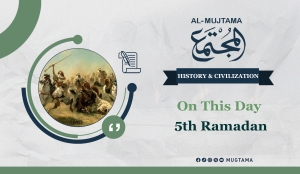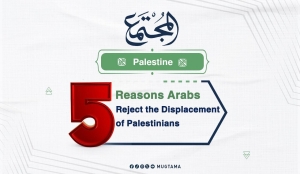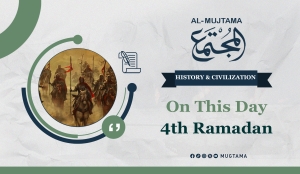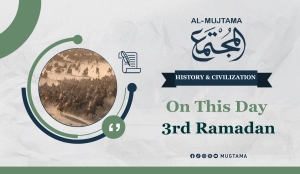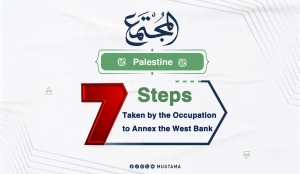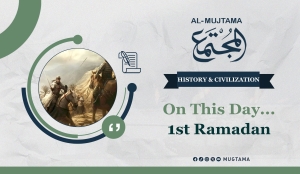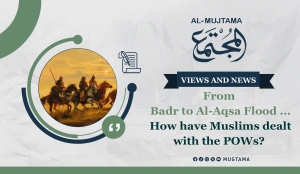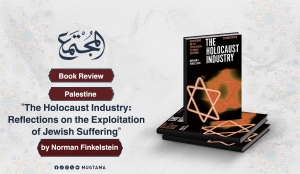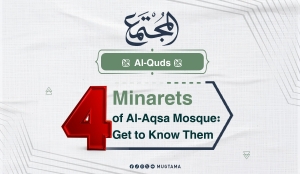Nada Gamal
On This Day 5th Ramadan
March 05, 2025- Lydda Massacre (5th Ramadan 1367)
- Battle of Bir al-Ghabi, Libya (5th Ramadan 1342 AH)
Lydda Massacre (5th Ramadan 1367)
On 5th Ramadan 1367 AH, July 11, 1948, to relieve the besieged city of Jerusalem from military pressure, Zionist forces launched a large-scale military operation. Known as Operation Dani, it aimed to occupy the cities of Lydda and Ramla.
The Defense of Lydda
Despite their limited capabilities, Lydda's defenders showed great resistance. Yet, two days later, Zionists succeeded in occupying the city. On the third day, they perpetrated a brutal massacre against its Arab residents.
The Massacre
Although some residents sought refuge in the Dahmash Mosque, Zionists didn't spare them. More than 400 Arabs were killed, and the survivors were forced to seek refuge outside their city.
Battle of Bir al-Ghabi, Libya (5th Ramadan 1342 AH)
This battle is considered one of the most important battles of the Libyan jihad against the Italian occupation. The Italians were following the movements of the Mujahideen Sheikh Omar al-Mukhtar and were waiting for the first opportunity to eliminate him and extinguish the struggle launched by him and his companions the mujahideen against the occupation.
The Ambush
During his return from Egypt and his crossing of the Libyan border, seven Italian armored cars ambushed him in one of the villages of Bir al-Ghabi - about 80 kilometers south of Tobruk. The Mujahideen clashed with them and shot them, and that was on April 23, 1923, 5th Ramadan 1342 AH.
The Battle
The Italian forces retreated a little to a nearby resort, then returned quickly, and were distributed tightly. The soldiers began to come down and put the wools in front of them to protect them from bullets. All the attacking Italians, with the exception of one armored vehicle, managed to escape, while three of the Mujahideen were martyred.
5 Reasons Arabs Reject the Displacement of Palestinians
March 05, 2025
In light of the ongoing Israeli occupation and its attempts to alter the demographic reality in Palestine, the Arab refusal to displace Palestinians emerges as a central issue that reflects a commitment to the historical and humanitarian rights of this people. This rejection is not only rooted in national and historical dimensions but is also based on legal and ethical foundations that reinforce the right of Palestinians to remain in their land and to return to it.
In this context, we present five main reasons that drive Arabs to reject any attempts to uproot Palestinians from their homeland:
- the right to return:
The Arabs reject the displacement of Palestinians because they believe that Palestinians have the right to return to their lands from which they were displaced following the Nakba of 1948. They believe that this right is part of humanitarian justice and the fundamental rights that peoples should enjoy.
- National Identity.
The issue of the displacement of Palestinians contradicts the preservation of Palestinian national identity, and Arabs believe that the Palestinian people have a long history and culture that is deeply rooted in their land. Their displacement reinforces the occupying state's attempts to obliterate this identity.
- Recognition of Palestinian rights:
The Arab rejection reflects a refusal to the attempts of the occupying state to cancel or manipulate the rights of Palestinians, including the right to establish an independent state on their lands. They emphasize that the displacement of Palestinians constitutes a violation of fundamental rights and leads to deepening injustice against them.
- Arab solidarity:
The Palestinian people are not alone in their plight, and the Arab world feels a responsibility towards the Palestinians as part of the Arab nation. Arab support for the Palestinian cause reflects this solidarity.
- International Law:
The expulsion of Palestinians contradicts the fundamental principles of international law, especially the United Nations Charter, which emphasizes the right of peoples to self-determination. Therefore, Arabs condemn any attempts to evict them or uproot them from their lands.
On This Day 4th Ramadan
March 04, 2025Recovery of Antioch from the Crusaders in 491 AH 1268 AD
The Islamic Conquest of Antioch
Antioch is one of the cities of Levant that was covered by the Islamic conquest during the reign of Caliph Umar ibn al-Khattab, may God be pleased with him. This city remained in the hands of the Muslims until the Crusades began against the lands of Islam in the year 491 AH.
Crusaders' Occupation of Antioch
Antioch was one of the first cities that the Crusaders were keen to occupy, due to its position controlling the roads located in the northern regions of the Levant. After its occupation, Antioch became the Crusaders' impregnable fortress in the north of the Levant, and it remained under their rule for nearly 170 years.
Baybars' Campaign to Recover Islamic Cities
When al-Zahir Baybars assumed power in 658 AH, he decided to recover the Islamic countries from the hands of the Crusaders. Baybars expelled the Tatars from the Levant, and began to conquer other cities one after the other. He conquered Caesarea, Arsuf, and Safed, then took Karak and Jaffa, and bombarded the castle of Acre.
The Siege and Conquest of Antioch
Baybars paved the way for the conquest of Antioch by isolating it from neighboring cities and cutting off all supplies. He divided his army into three teams: one headed to the Swedish port to sever the connection between Antioch and the sea, another headed north to block the passages between Qalqilya and the Levant to prevent supplies from Lesser Armenia, and the main division, led by Baybars, headed directly to Antioch.
Baybars laid a tight siege around Antioch and was able to enter the city on Ramadan 4, 666 AH / September 24, 1268 AD. The fall of Antioch is considered the greatest conquest the Muslims achieved against the Crusaders after the Battle of Hattin.
The Death of the Ottoman Caliph Abdul Hamid II
Early Life and Ascension
Sultan Abdul Hamid II, the son of Sultan Abdul Majeed I, the Ottoman, was born in the year 1258 AH. He assumed the caliphate in the year 1293 AH / 1876 AD, taking over the state while it was burdened with internal and external problems.
Internal and External Challenges
At home, he faced the confrontation of secular and Freemasonry movements. Abroad, Russian threats appeared strongly in the form of two successive wars. He also had to confront the British occupation of Egypt, Sudan, and Cyprus, and the French occupation of Algeria and Tunisia. Additionally, he dealt with fierce revolutions in the Balkans, especially in Bulgaria, Serbia, and Montenegro, with open and blatant incitement from the Russians.
Achievements and Reforms
Sultan Abdul Hamid II ruled for more than thirty years, during which he faced countless enemies at home and abroad. He saved the state from collapse after the war with Russia, suppressed the Cretan rebellion, defeated Greece, trained the army on modern fighting methods, opened various schools and universities, expanded urbanization, and established the Hijaz railway from Damascus to Medina, which was 1327 km long.
Confronting Jewish Attempts to Buy Palestine
One of the most important works of Sultan Abdul Hamid, in addition to establishing the Islamic University to confront Westernization, secularism, and Freemasonry movements, was his courageous response to the desperate attempts of the Jews to buy Palestine. This led to his eventual removal from office in 1327 AH / 1909 AD, orchestrated by the Dönmeh Jews in cooperation with international Zionism and the National Union and Progress Movement.
Exile and Death
Sultan Abdul Hamid II died in exile in Paris at the age of 76. He spent 20 years in exile after the abolition of the caliphate and his expulsion from Turkey in March 1923. He was buried in Medina in the land of the Two Holy Mosques.
On This Day 3red Ramadan
March 03, 2025Death of Lady Fatima Al-Zahra:
On the third of the month of Ramadan in the year eleven of the Hijra, the daughter of the Messenger of Allah, Fatima (may Allah be pleased with her), passed away and was buried in Al-Baqi at night. And that was six months after the death of the Prophet ﷺ.
Ali ibn Abi Talib married her after the migration and four months after the Battle of Badr. She gave birth to Hassan, Hussein, and Um Kulthum, who later married Umar ibn al-Khattab.
The Prophet Muhammad (peace be upon him) would visit his daughters after their marriages, bringing them joy and happiness. Among his practices with his daughters after their marriages was visiting them, inquiring about them, and intervening to reconcile them with their husbands if there was a problem that he was aware of. He did this in a way that ensured the restoration of harmony within the family if it served their interest. He visited Fatimah (may Allah be pleased with her) after her marriage and prayed for her and her husband, asking Allah to protect them and their offspring from the accursed Satan.
The Prophet, peace be upon him, said about his daughter Fatima: (Fatima is a part of me, and whoever makes her angry, makes me angry.") Sahih al-Bukhari 3767
The fall of the Abbasid Caliphate at the hands of the Buyids and the entry of Jalal al-Dawla into Baghdad:
The Buwayhids, who were Persian Daylamites from northern Iran, occupied them for almost a century, from the mid-4th century to the mid-5th century AH (Islamic calendar). The Buwayhids were Shia, advocating for their sect and firmly controlling the Abbasid state, Iraq, and Persia.
Under the rule of the Buyids, the situation of the caliphs worsened, and the country suffered from deteriorating political and economic conditions.
The Abbasids became increasingly frustrated with the Buyids, so they sought the help of the Seljuk Turks, the rising Islamic power in the region. What "Toghrul Beg" did was enter Baghdad with his army and put an end to the Buyid state in the year 1055 AD. At that time, a great upheaval occurred, in which the markets were burned, and looting and killing became rampant.
The Mustansir takes over Al-Andalus following his father
He is the ninth prince of the Umayyad state in Andalusia. His era was a continuation of the period of the Umayyad state's prominence in Andalusia.
His era is characterized by the flourishing of science and literature in Córdoba to a great extent. He was the most book-loving of the Umayyad caliphs and would send men with huge sums of money to acquire rare books for Al-Andalus. He established the Library of Córdoba, which contained up to four hundred thousand volumes.
Education experienced a great renaissance during the reign of Al-Hakam. Literacy spread among the people, whereas the highest-ranking individuals in Europe, except for the clergy, were often illiterate. Al-Hakam established a school to educate the poor for free, and he founded the University of Córdoba, which was one of the most famous universities in the world at the time. Its main hub was the Great Mosque, where all sciences were taught and the greatest scholars were chosen to teach.
The great Spanish scholar, Fendith Bidal, says: "The Andalusian caliphate reached the peak of its splendor during that era, extending its peaceful sovereignty over all of Spain, thereby ensuring public tranquility
7 steps taken by the occupation to annex the West Bank
March 03, 2025The Israeli occupation continues to implement its settlement project in the West Bank at an unprecedented pace, taking advantage of the international focus on the war in Gaza and regional developments.
These moves come under the leadership of far-right Finance Minister Bezalel Smotrich, who does not hide his open intentions to annex the entire West Bank, considering it part of "Greater Israel."
Through a series of measures that integrate administrative decisions, significant funding, and legal regulations, the occupying authorities are working to formally annex the West Bank de facto, without the need for an official declaration; this reflects a new approach that relies on gradualism rather than direct diplomatic confrontation.
In this context, the Israeli government adopted seven main measures to strengthen its grip on the West Bank, establishing a reality that makes the establishment of an independent Palestinian state more difficult than ever, according to a report published by the Negotiations Affairs Department of the Palestine Liberation Organization
- Transferring powers from the military to a civilian administration:
The occupying authorities have completed the transfer of the authority to manage the settlements from the military to a new civilian administration under the leadership of Finance Minister Bezalel Smotrich. A "civil deputy" has been appointed, who has been granted the powers of the head of the civilian administration; this means that decisions related to the settlements are no longer in the hands of the military but are instead in the hands of civilian entities that are directly under the control of the far-right government.
- Legalization of settlement outposts:
The occupation resorted to creating a "path of agreement for legitimacy," aimed at granting official legitimacy to illegal settlement outposts; this allows for their funding and the provision of services to them. An amount of 85 million shekels has been allocated to support these outposts and enhance security within them, which encourages more settlers to move there, thereby entrenching Zionist control over new areas of the West Bank.
- Seizing more land:
"Israel" has announced 24,193 dunams (one dunam = 1,000 square meters) as "state land," with the aim of expanding settlement areas, legalizing agricultural outposts, and accelerating the implementation of new settlement plans. This policy is not new, but it has significantly accelerated in recent years, as the occupation uses legal and administrative means to seize Palestinian lands and reallocate them in favor of settlements.
- Massive financial support for settlement:
The occupying government has provided unprecedented financial support to the settlements by allocating one billion shekels (the dollar = 3.7 shekels) to cover the security needs of the settlements for the years 2024-2025, in addition to seven billion shekels to expand the network of roads for the settlers.
The funding aims to strengthen the infrastructure that makes the presence of settlers in the West Bank more sustainable, while Palestinians are being denied the opportunity to develop their basic infrastructure.
- Devoting discrimination in favor of the settlers:
The occupation authorities launched what is called "Equal Citizenship Reform," which is a project aimed at improving public services provided to settlers through government ministries, while Palestinians in the West Bank continue to live under exclusionary and restrictive policies. This "reform" reinforces systemic discrimination and grants settlers additional privileges, making the reality of annexation more entrenched.
- Imposing Zionist laws on the settlers:
The occupying government has completed the imposition of its civil laws on settlers through military orders, which means that the settlements are now effectively subject to "Israeli" law, rather than the military law that is supposed to apply to the occupied territories. This step reinforces the legal separation between settlers and Palestinians, making the settlements closer to being part of the occupying state, while Palestinians are deprived of any equal legal rights.
- Establishing a legal unit for annexation:
In a new step, the Israeli Ministry of Defense has established a new legal advisory unit under the supervision of Smotrich, which will take over the responsibilities of the civil administration that were previously under the control of the military. This shift reflects the occupation's desire to transform the West Bank into an area subject to direct civil administration, thereby reinforcing the actual annexation without the need for an official declaration. This is a blatant violation of international law and the Geneva Conventions.
On This Day 1st Ramadan
March 01, 2025The Return of the Army of Hardship to Medina Victorious
On the first of Ramadan, the Prophet Muhammad (PBUH) returned to Medina from the Battle of Tabuk victorious without fighting the Romans. He spent fifty days, twenty of which were in Tabuk, and the rest traveling. The Romans had prepared an army of forty thousand men to eradicate Islam from its roots. The Muslim army, called the Army of Hardship due to the timing before harvest and the difficulty of the journey, was composed of thirty thousand Muslims. Abu Dhar al-Ghifari was among those who lagged behind due to his slow camel. The Prophet said, "Leave him, for if there is good in him, Allah will bring him to you, and if not, you have been relieved of him." Abu Dhar then carried his belongings on his back and followed the Prophet's trail, walking. Upon seeing him, the Prophet said, "May Allah have mercy on Abu Dhar. He walks alone, dies alone, and will be resurrected alone." The hypocrites and those whom Allah forgave, mentioned in Surah At-Tawbah, did not participate.
Siege of the Babylon Fortress and the Islamic Conquest of Egypt
On the first of Ramadan in the year 20 AH (16 August 641 CE), Amr ibn al-As marched to the Babylon Fortress and besieged it for seven months. The Romans proposed to pay a sum of money for the Muslims to return, but Amr ibn al-As refused and stated that there were only three options: Islam, the Jizya tax, or fighting. The fortress garrison and the Roman Emperor Heraclius refused to surrender. Zubair ibn al-Awwam and a group of Muslim soldiers climbed the fortress walls, leading the Romans to believe the Muslims had breached, causing them to flee. After opening the gates, the Romans surrendered and requested peace, which Amr ibn al-As granted.
The Conquest of Andalusia
On the first of Ramadan in 91 AH (6 July 710 CE), Musa ibn Nusayr, with the approval of Caliph Al-Walid ibn Abd al-Malik, initiated the conquest of Andalusia. He appointed Tariq ibn Ziyad as governor of Tangier. The initial expedition consisted of 500 soldiers, and eventually, Islam ruled Andalusia for eight centuries until the Christian Reconquista.
The Birth of Imam Sahnoun
On the first of Ramadan in 160 AH (15 June 777 CE), Imam Sahnoun was born in Kairouan. He studied in the East and returned to propagate the Maliki school of jurisprudence in Africa and Andalusia, becoming its most prominent scholar. Among his notable works is the "Al-Mudawwana al-Kubra."
The Death of Ibn Sina (Avicenna)
On the first of Ramadan in 427 AH (3 July 1037 CE), the famous Muslim polymath Ibn Sina passed away. Known for his contributions to medicine and philosophy, his works, including "The Canon of Medicine," remained central in Europe until the 17th century.
The Burning of Al-Masjid an-Nabawi
In the year 654 AH (28 September 1256 CE), the Prophet's Mosque in Medina suffered a devastating fire, destroying many historical relics. The fire, caused by a neglected flame, coincided with an earthquake and volcanic eruption in the region.
The Conquest of Egypt:
On the first of Ramadan in the year 20 AH (16 August 641 CE), Amr ibn al-As led the Muslim army to the fortress of Babylon in Egypt, where they besieged it for seven months. The Roman forces, led by the governor Al-Muqawqas, proposed a sum of money for the Muslims to retreat, but Amr ibn al-As refused, demanding either conversion to Islam, payment of the jizya (tax), or battle. The Romans eventually surrendered, and Egypt was opened to Islam.
The Conquest of Al-Andalus (Spain):
In the first of Ramadan, in the year 91 AH (6 July 710 CE), Musa ibn Nusayr, with the support of the Umayyad Caliph Al-Walid ibn Abd al-Malik, initiated the conquest of Al-Andalus. Tariq ibn Ziyad, the governor of Tangier, led the campaign, and the Muslims successfully established control over the Iberian Peninsula, which remained under Islamic rule for nearly eight centuries.
The Birth of Imam Sahnun:
On the first of Ramadan in the year 160 AH (15 June 777 CE), Imam Sahnun was born in Kairouan. He was a prominent scholar of the Maliki school of thought in North Africa and Andalusia. Imam Sahnun played a significant role in spreading Maliki jurisprudence and authored the famous "Al-Mudawwana," a compilation of Maliki legal opinions.
The Death of Ibn Sina (Avicenna):
On the first of Ramadan in the year 427 AH (3 July 1037 CE), the renowned Muslim scholar Ibn Sina, also known as Avicenna, passed away. He was a polymath who made significant contributions to various fields, including medicine, philosophy, and science. His most famous work, "The Canon of Medicine," remained a standard medical text in Europe for centuries.
The Burning of Al-Masjid an-Nabawi (The Prophet's Mosque):
On the first of Ramadan in the year 654 AH (28 September 1256 CE), a devastating fire broke out in the Prophet's Mosque in Medina. The fire caused extensive damage to the mosque, including the destruction of historical artifacts and relics dating back to the time of the Prophet Muhammad (PBUH) and his companions. This event coincided with a volcanic eruption in the region.
The war in Islam is a means whose ultimate goal is peace and the establishment of justice and kindness in human life. It is governed by noble morals and ideal principles, among which is good treatment of prisoners.
The POWs of Badr.
Seventy men from the polytheists were captured by the Muslims. The Prophet ﷺ treated them gently and decided to exempt them from execution, allowing ransom from those who could afford it, with the amount and type of ransom varying based on the situation of each captive. Those without money could ransom themselves by teaching some Muslims reading and writing. The Prophet released some captives and granted them freedom without ransom, and he treated Suhayl ibn Amr well, one of the orators of the polytheists who had incited people against him and spoke ill of him. The Prophet ﷺ was prompt in instructing his companions on how to treat their captives well, highlighting how Muslims should behave towards their captives. The companions, may Allah be pleased with them, adhered to his command, to the extent that they prioritized the captives over themselves. Abu Aziz ibn Umayr said: "I was among the captives on the day of Badr. The Prophet ﷺ said, 'Treat the captives kindly.' I was with a group of the Ansar, and when they brought out their food for lunch and dinner, they ate dates and gave me bread.
The companions, may Allah be pleased with them, would offer the captives wheat bread despite their love for it, and they would eat dates instead. Their situation in prioritizing the captives was similar to their prioritization of the needy, and thus they deserved Allah's praise, as Allah the Exalted said.( and give food—despite their desire for it—to the poor, the orphan, and the captive (8) saying, ‘We feed you for the sake of God alone: We seek neither recompense nor thanks from you.(9) ) (Al-Insan)
The matter did not stop there; rather, Allah, Glory be to Him and Exalted, consoled the captives regarding what was taken from their ransom. He promised those among them whom He knew had goodness in them what would be better for them. Thus, they received the care of Allah, the Almighty, just as they received the care of His Messenger, peace be upon him. Allah, the Exalted, said, addressing His Prophet: (O Prophet! Tell the captives in your custody, “If Allah finds goodness in your hearts, He will give you better than what has been taken from you and forgive you. For Allah is All-Forgiving, Most Merciful.) (Al-Anfal:70)
The Guidance of the Prophet ﷺ and the Rulings of Islam.
The guidance of the Prophet ﷺ was to treat prisoners of war kindly, and this often led to their conversion to Islam and changed their circumstances. Safana bint Hatem al-Ta'i was captured by the Muslims and brought to Medina. The Prophet ﷺ passed by her, and she stood up to speak to him about herself, saying: "My father has died and the one who used to provide for us is absent, so grant me a favor from Allah.
When the Prophet Muhammad (peace be upon him) learned of her story and recognized her father, he freed her and treated her kindly. Safana said: So, the Messenger of Allah (peace be upon him) clothed me, carried me, and provided me with expenses.
The Muslims captured Thumamah ibn Uthal al-Hanafi and brought him to Medina, where they tied him to one of the pillars of the mosque. Thumamah was the chief of Banu Hanifah in the land of Yamamah. The Prophet Muhammad (peace be upon him) went out to him and said, "What do you have to say, O Thumamah?
Thumamah said: "I have good news for you, O Muhammad. If you kill me, you will kill someone with blood (a person of status); if you grant me kindness, I will be grateful; and if you want money, ask for whatever you wish."
He was left until the next day. The Prophet ﷺ asked him: "What do you have, O Thumamah?"
He replied: "What I told you, if you grant me kindness, I will be grateful."
He was left until after the next day, and the Prophet ﷺ asked him again: "What do you have, O Thumamah?" He replied: "I have what I told you."
So, the Prophet ﷺ said: "Release Thumamah.
He went to a palm tree near the mosque, bathed, and then entered the mosque, saying: "I bear witness that there is no god but Allah, and I bear witness that Muhammad is the Messenger of Allah." He added, "O Muhammad, by Allah, there was no face on earth that I hated more than your face, but now your face has become the most beloved face to me. By Allah, there was no religion that I hated more than your religion, but now your religion has become the most beloved religion to me. By Allah, there was no country that I hated more than your country, but now your country has become the most beloved country to me. And my horse brought me to you while I was intending to perform Umrah, so what do you think?
The Messenger of God - peace be upon him - gave him good news and instructed him to perform Umrah. When he arrived in Mecca, someone asked him: "Have you turned away from your religion?" He replied: "No, but I have embraced Islam with Muhammad, the Messenger of God - peace be upon him - and by God, no grain of wheat will come to you from Al-Yamama until the Prophet - peace be upon him - gives permission for it." (Reported in Sahih al-Bukhari)
The Prophet's forgiveness towards the captives of Hawazin
After the Muslims were victorious in the Battle of Hunayn against Hawazin (a large and well-known Arab tribe in the Arabian Peninsula), they gained many spoils from this battle. Then, a delegation from Hawazin came and announced their Islam; this delegation consisted of fourteen individuals representing the various clans of Hawazin, except for Thaqif. They asked the Prophet Muhammad (peace be upon him) to return to them their wealth and what had been taken from their women and children during the Battle of Hunayn. They said, "O Messenger of Allah! We are a clan and a family, so be gracious to us, as Allah has been gracious to you. Indeed, we have been afflicted with trials that are not hidden from you." Zahir bin Sard, one of the Banu Sa'd bin Bakr (the tribe of Halima al-Sa'diyah), said, "O Messenger of Allah, your aunts and maternal relatives and those who nursed you are in the captives," and they then asked him to return their wealth and captives.
The Prophet Muhammad (peace be upon him) hastened to respond to the request of Hawazin due to what was known of him in terms of mercy, forgiveness, and generosity. It was narrated by Al-Maswar ibn Makhramah and Marwan ibn al-Hakam that when a delegation from Hawazin came to the Prophet (peace be upon him) as Muslims, they asked him to return their wealth and captives to them. The Prophet (peace be upon him) said to them: "The most beloved speech to me is the truest one, so choose one of the two parties (either the wealth or the captives). I have been waiting for them." The Prophet (peace be upon him) had waited for them for more than ten nights after he returned from Ta'if. When it became clear to them that the Prophet (peace be upon him) would only return to them one of the two parties, they said: "We choose our captives." The Prophet (peace be upon him) stood up before the people, praised Allah as He deserves, and then said: "As for what follows, your brothers have come to us in repentance, and I have seen that I should return their captives to them. Whoever among you would like to make that easy (return their captives willingly), let him do so. And whoever would like to keep his share (of the captives) until we give it to him from what Allah will grant us first, let him do so." The people said: "We have made it easy." He then said: "Indeed, we do not know who among you has given consent and who has not, so return until your leaders convey your decision to us." The people returned, and their leaders spoke to them, and then they came back to the Prophet (peace be upon him) and informed him: "We have made it easy and given our consent." This is what has reached us regarding the captives of Hawazin." (Narrated by Al-Bukhari).
The treatment of prisoners by the Crusaders.
Jerusalem fell in 1099 AD due to several factors, including the weakness of the Abbasid Caliphate in Baghdad and the Fatimid control of Egypt. The Islamic weakness in the provinces gathered the ambitions of the Crusader campaigns, which became like a cancer gnawing at the body of the nation.
The Crusades were military campaigns that began to invade Muslim lands under the pretext of rescuing and protecting holy sites from Muslims. However, their primary aim was colonial in nature. Regarding the entry of the Crusaders into Jerusalem, as Ibn Al-Athir states in his history, "The Franks took Jerusalem on a Friday, seven days before the end of Shaban, and the people wielded swords. The Franks remained in the city for a week, killing Muslims. A group of Muslims sought refuge in the shrine of David, where they held out and fought for three days. The Franks killed more than seventy thousand in Al-Aqsa Mosque, including a large number of Muslim leaders, scholars, worshippers, and ascetics, who had left their homelands and sought proximity to that holy place.(1)
As Stephen Runciman described in his book "A History of the Crusades," what happened in Jerusalem on the day the Crusaders entered: "In the early morning of the following day, a group of Crusaders stormed the gate of the mosque, exterminating all the refugees inside. When the leader of the force, Raymond of Toulouse, went to visit the Temple area in the morning, he had to feel his way among the bodies and the blood that reached his knees. The massacre of Jerusalem left a profound impact on the entire world, and the exact number of its victims is not known; however, it led to the city being emptied of its Muslim and Jewish inhabitants. In fact, many Christians were deeply distressed by what had happened.
The Tolerance and Elevation of Salah al-Din.
When Salah al-Din entered Jerusalem as a conqueror, he did not seek revenge or kill; in fact, the victorious Muslims were renowned for their integrity. The just king was moved by the sight of the prisoners' misery and asked his brother Salah al-Din to release a thousand captives, which he granted. The just king immediately set them free and Salah al-Din declared that he would release all the elders and elderly women.
This act is not only with the residents of the city, but we also see the clergy, led by the Patriarch of Jerusalem, as he pays the ten dinars amount required for the ransom.
The women of the Crusaders approached, their eyes filled with tears, asking Saladin what would become of them after their husbands or fathers had met their fate, or had been taken captive. Saladin responded by promising to release all those in captivity from their husbands, and he offered gifts from his treasury to widows and orphans—each according to their situation. His compassion and kindness were in stark contrast to the actions of the invading Crusaders.
The Great Seljuks' Treatment of Prisoners
We do not forget the immortal Battle of Manzikert and its hero, Sultan Alp Arslan. In this battle, which was against the Byzantine Empire that had prepared to take revenge on Sultan Alp Arslan and the Seljuks, God granted victory to the Muslims and helped them, leading to the death of many of the enemy's troops, and their king, Romanus, was captured.(2) When he stood before King Alp Arslan, Alp Arslan said: "If I were the captive before you, what would you do?" He replied: "Every kind of disgrace." The king asked: "What do you think I would do to you?" He said: "Either you would kill me and disgrace me in your land, or you would pardon me and take a ransom and send me back." The king said: "I have decided on nothing but pardon and ransom." So, he was ransomed for one million dinars and five hundred thousand dinars. He stood before the king and was given a drink of water, then he prostrated himself on the ground before him. The king sent a military escort with him to protect him back to his country, along with a banner inscribed with "There is no god but Allah, and Muhammad is the Messenger of Allah.(3)
The Dust and the Pleiades
The greatness of Islam is evident in the treatment of prisoners when we compare Muslims with other nations. The Romans in ancient times and before them the Assyrians and the Pharaohs would blind their eyes, skin them alive, and feed their flesh to their dogs. As a result, prisoners would prefer death over life. This has no place in the law of the One who said to Him in His clear Book. (We have sent you ˹O Prophet˺ only as a mercy for the whole world.) (Al-Anbya : 107)
What we are witnessing now in occupied Palestine between Palestinians and Zionists regarding the treatment of prisoners—these displays show us the significant differences between the two sides, which prompts us to remind ourselves of this. The Palestinians, for their part, have adhered, to the extent possible, to the noble teachings of Islam regarding the good treatment of prisoners. This has been acknowledged by Zionist media, according to testimonies from prisoners returning from the Gaza Strip. They confirmed that they found good treatment from the Palestinians, and that they were never subjected to any form of violence or humiliation. In fact, the impact of the good treatment of prisoners by some Palestinians has led a few who witnessed how the Palestinians treated the prisoners to declare their conversion to Islam, while those who did not convert expressed their gratitude.
Indeed, the prisoners themselves, upon their return, expressed their gratitude for the kind treatment they received. This refutes any claims of pressure being exerted on them and provides evidence of their sincerity as they bid farewell with words of thanks and smiles.
While the Palestinians were creating this magnificent image, we were witnessing a bleak situation on the other side in dealing with the prisoners. The Israelis inflicted severe torture on the Palestinian prisoners, and it reached a point of rape and sending them off with humiliating beatings, resulting in their release in a sickly state, suffering from malnutrition and various diseases. The repression even extended to preventing the families of the prisoners from celebrating their return.
The distance between the two east
The clear difference between the treatment of prisoners by them and by the Palestinians besieged in the Gaza Strip is the difference between the people of faith and Islam and the people of disbelief and crime. The occupation would not have released the Palestinian prisoners if it had not been able to break the will of the resistors, despite all the killing, destruction, displacement, and exile it caused, and despite all the acts of genocide and crimes against humanity it committed. This means that this war is a war of will and determination, not a war of killing and destruction.
The Palestinians were able, with the modest resources they had, to withstand a heavily armed army that was said to be invincible and unbeatable, one that had weapons beyond imagination, as their brothers supported them in their struggles and spared no effort.
Despite this, he has failed to achieve his declared goals and has reluctantly accepted the conditions of the truce. Do people realize these meanings? Some see nothing but destruction and the loss of lives. Have they failed to see the people of Gaza?! They declare their pride with dignity and honor: "Indeed, their suffering is immense, but their goal is great; their calamity is evident, but their certainty is strong; their despair is significant, but their patience is beautiful; and the conspiracy against them is vast, yet they trust in the Most High. The enemy may return to attack, and they will greet him as they did the first time, defending themselves with great steadfastness." Allah, the Almighty, has said...( they prayed, “Our Lord! Shower us with perseverance, make our steps firm, and give us victory over the disbelieving people.) (Al-Baqarah:250)
____________________
- The Complete History by Ibn Al-Athir, Volume 8, pages 189-190
- The Ottoman Empire: Factors of Rise and Reasons for Decline by Dr. Ali Muhammad Al-Salabi, page 31
- The previous source, quoting from "Al-Bidaya wa al-Nihaya" (12/108).
Book Review "The Holocaust Industry: Reflections on the Exploitation of Jewish Suffering
February 17, 2025The book "The Holocaust Industry: Reflections on the Exploitation of Jewish Suffering" is a critical work by American Jewish academic and researcher Norman Finkelstein, published in 2000. It addresses the topic of the "Holocaust" from two main perspectives: the first concerns the interpretation of the narrative surrounding the "Holocaust," and the second focuses on how that narrative is exploited for political and commercial purposes.
The book stirred wide controversy, as it faced criticism from some Jewish and Zionist circles. It was translated into Arabic twice; the first time by Samah Idris in 2000, and the second time by Saud Attia in 2001.
Finkelstein criticizes the excessive and misleading use of the history of the "Holocaust" by certain groups and organizations, particularly those that benefit from perpetuating the image of the Jewish victim.
He believes that some Jewish organizations, such as the "American Jewish Union," have exploited the "Holocaust" as a political pressure tool to achieve their interests, such as strengthening military and financial support for the occupying state.
It also directs sharp criticism at some academics who work to establish the image of the "Holocaust" as a unique event that cannot be questioned, despite the fact that the book calls for recognizing other historical atrocities such as the Armenian genocide.
Finkelstein compares the "Holocaust" to the suffering of other minorities that have faced persecution and extermination in various parts of the world, warning against the selective use of the "Holocaust" to pressure people or distort historical facts.
The media figure Ahmad Mansour says in an interview on the program "Without Boundaries" with the author of the book in 2004: "Although the book does not exceed 160 pages, the number of articles written about it is not in the dozens, but in the hundreds. These articles have been published in most Western newspapers, especially the reputable and famous ones."
Mansour added that the book presents a bold study that reveals the "Holocaust" industry, unveiling the groups behind it and their objectives, as well as the means and methods employed by the Jewish lobby to blackmail countries around the world.
The book, according to Mansour, also discusses how these individuals obtained tens of billions of dollars in compensation for the victims of the "Holocaust," which were subsequently distributed to "Israel" and Jewish groups, in addition to layers of lawyers and other beneficiaries.
The main axes of the book.
- The Manufacture of the 'Holocaust
The book indicates that the "Holocaust" has become part of a cultural and historical industry that benefits a certain group, and how the Jews have been able to exploit this suffering to achieve political, economic, commercial, and social gains. It sharply criticizes the Zionist and Jewish institutions, some of which profit from this suffering.
- political exploitation
The book explains how the "Holocaust" is used by some political powers to achieve special interests, and how it is exploited as a tool for political and economic manipulation, focusing on how Zionist institutions and some governments exploit this historical event to achieve material and moral gains.
- Skepticism about the official narrative
The author calls for a critique and review of some academic and media positions related to the "Holocaust," and the exaggeration in presenting its events in order to create a public opinion and a broad narrative around it, which affects the objective understanding of historical events in favor of the Jews.
- The role of "Israel" in exploiting the "Holocaust":
The text discusses how the occupying state has used the "Holocaust" as a means to enhance its political legitimacy and international support, and how it is exploited to justify "Israel's" policies against the Palestinians, gain international sympathy for them, and strengthen its position in the conflict.
4 Minarets of Al-Aqsa Mosque: Get to Know Them
February 12, 2025The Al-Aqsa Mosque has four minarets, all of which were built during the Mamluk era, between the years 677-769 AH (1278-1367 AD). Three of these minarets are located along the western side of Al-Aqsa Mosque, starting from Bab al-Ghawwamah (the Gate of the Ghawwamah), then Bab al-Silsilah (the Gate of the Chain), and finally Bab al-Magharbah (the Gate of the Moroccans). The fourth minaret is situated on the northern side, between Bab al-Asbat (the Gate of the Tribes) and Bab al-Hutta (the Gate of Hutta).
The absence of minarets on the southern and eastern sides is due to the fact that Al-Aqsa was built on a hill that rises in the middle and north and declines in the east and south. Minarets require a solid and elevated location. Additionally, human and residential activity after the Umayyad period was concentrated in the western and northern areas, making the need for minarets in these regions greater than in others.
- 1. Minaret of Bab al-Magharbah (The Honorary Minaret):
This minaret is located at the southwestern corner of Al-Aqsa Mosque, close to Bab al-Magharbah, precisely above the northwestern corner of the Women's Mosque. It is named the Honorary Minaret in reference to Sheikh Judge Sharaf al-Din ibn Fakhr al-Din al-Khalili, the custodian of Islamic endowments in the city of Jerusalem, who oversaw its construction along with the nearby Fakhriah School in the year 677 AH (1278 AD).
This minaret was built without a foundation and is considered the smallest minaret of Al-Aqsa Mosque, standing at only 23.5 meters tall. The upper part of it was damaged in an earthquake in 1341 AH (1922 AD), after which the Higher Islamic Council demolished and rebuilt it in the same year in a beautiful style, placing a dome on the upper square that had not existed before. Recently, the Al-Aqsa Mosque Reconstruction Committee restored it and covered its dome with lead.
Today, one can ascend to the minaret from the courtyards of Al-Aqsa Mosque via 50 steps leading up to the Islamic Museum (formerly the Mosque of the Moroccans). For many years, the minaret has been fighting attempts by the occupiers to silence the call to prayer, claiming that it disturbs them, which forced the Islamic Waqf Administration in Jerusalem to adjust the loudspeakers so that they point inward towards Al-Aqsa and reduced their volume, depriving the residents of the village of Silwan, located south of the blessed Al-Aqsa, from hearing its call.
- 2. Minaret of Bab al-Silsilah:
It stands above the western arcade of the Al-Aqsa Mosque, slightly to the north of Bab al-Silsilah, and is also known as the Minaret of the Court, as it is located near the Sharia Court building, which is also known as the Tinkaz School.
Both the minaret and the school are buildings of Prince Sayf al-Din Tinkaz al-Nasiri, built in the year 730 AH (1329 AD) during the reign of Sultan al-Malik al-Nasir Muhammad ibn Qalawun. The Higher Islamic Council rebuilt it after an earthquake damaged it in 1341 AH (1922 AD), and it was also restored a few years ago by the Al-Aqsa Mosque Reconstruction Committee.
One can ascend to it through the entrance of the Ashrafiya School via approximately 80 steps. Its base is square, and it stands at a height of 35 meters.
The Minaret of Bab al-Silsilah is considered the only minaret among the four minarets of Al-Aqsa Mosque from which the muezzins have been calling the adhan daily until the use of loudspeakers began in the muezzins' room facing the gate above the courtyard of the Dome of the Rock.
The minaret is located in a very sensitive position, overlooking the occupied Buraq Wall, which has been referred to as the Western Wall by the occupation since 1967.
3- Minaret of Bab al-Ghawanima:
It is located on the northern arcade of the blessed Al-Aqsa Mosque at its far west near Bab al-Ghawanima, which is named after it. Its current construction dates back to the era of Sultan al-Malik al-Mansur Hossam al-Din Lajin in the year 697 AH / 1297 AD, but some archaeologists state that it was originally built during the Umayyad period. It was renewed during the reign of the Mamluk Sultan al-Nasir Muhammad bin Qalawun in 730 AH / 1329 AD, and it was named "Qalawun Minaret." It was also called the Minaret of the Saraya due to its proximity to the Saraya building located outside Al-Aqsa Mosque, which served as a seat of authority during the Mamluk period. The Islamic Supreme Council renewed it in 1346 AH / 1927 AD during the British occupation.
It is the tallest and most ornate minaret of the blessed Al-Aqsa Mosque, with a height of 38.5 meters, and it rests on a square base, while its upper part is octagonal, accessed by 120 steps. Due to its height, which overlooks various aspects of Al-Aqsa, the Zionists sought to control it through the adjacent Omariyah School, which the occupying municipality had taken over since the beginning of the occupation. Additionally, the western tunnel opened in 1996 passes near the foundations of this minaret, resulting in its cracking, necessitating its last restoration in 2001.
4- Minaret of Bab al-Asbat:
This minaret is located on the northern arcade of the blessed Al-Aqsa Mosque between the gates of al-Asbat and Hatta. It is also known as the "Sulaymaniyah Minaret" because it is located near the Sulaymaniyah School outside the blessed Al-Aqsa Mosque, which became the Church of St. Anne during the Ottoman period.
This minaret was built during the reign of Mamluk Sultan al-Ashraf Shaban under the supervision of Prince Sif al-Din Qutlubgh in the year 769 AH / 1367 AD on a square base like the other minarets of Al-Aqsa. During the Ottoman period, it was rebuilt in a cylindrical shape similar to the Ottoman minarets, becoming the only cylindrical minaret in Al-Aqsa.
Its height is 28.5 meters, and it was cracked due to an earthquake in 1346 AH / 1927 AD, forcing the Islamic Supreme Council to demolish its upper section and rebuild it anew. When the Zionist occupation of Jerusalem occurred in 1967, the minaret was damaged from being hit by shells, and it was completely restored afterward by the Committee for the Reconstruction of the Blessed Al-Aqsa Mosque, and its dome was covered with lead.
Book Review: "Hamas... Unwritten Chapters
February 10, 2025
The book "Hamas... Unwritten Chapters" is published by the Zaytuna Center for Studies and Consultations in Beirut and authored by the Palestinian writer Dr. Azam Tamimi. The book, spanning 343 pages in medium size, offers the first two chapters for free download, allowing readers to access the beginning of this in-depth study on the "Hamas" movement.
New Chapters in the Movement's History
The book is a qualitative addition to understanding the "Hamas" movement's vision for itself and the world around it. It discusses the Palestinian-Israeli conflict from the movement's perspective, outlining its positions on various means of conflict resolution, revealing the principles that "Hamas" adheres to, and highlighting what it can accept for settlement and what political options it rejects.
The First Edition in Arabic
The first edition of this book was published in English in 2007 by Hurst Publishing in London. The Arabic edition presented by the Zaytuna Center is the first translated into Arabic, making it an essential reference for researchers interested in the subject.
Chapters of the Book
Chapter One: Beginnings:
The book begins by reviewing the incident that ignited the spark of the Palestinian uprising on December 8, 1987, as well as the conditions that contributed to the birth of the "Hamas" movement afterward. It also highlights the developments that occurred in the two decades leading up to the establishment of the movement.
Chapter Two: From Call to Jihad:
This chapter addresses the story of the "Muslim Brotherhood in Palestine" since 1977 when they began planning to launch their own resistance project, which took practical shape with the onset of the Palestinian uprising in 1987. It clarifies the role of Islamic institutions such as the Islamic Association and the Islamic University in supporting Palestinian society.
Chapter Three: Total War:
This chapter covers the development of the "Hamas" movement and the significant events that affected it after its establishment, starting from the repercussions of the First Intifada to the Oslo Accords signed between the Palestine Liberation Organization and "Israel" in 1993.
Chapter Four: To Jordan:
This chapter narrates the story of the transfer of the leadership of the "Hamas" movement to Jordan following Saddam Hussein's invasion of Kuwait and the pressures faced by the Jordanian authorities as a result of the Wadi Araba peace agreement. It also reviews the incident of Dr. Moussa Abu Marzook's detention in New York and the outcomes of this case.
Chapter Five: The Attempt on Mashal’s Life:
This chapter recounts the failed "Israeli" assassination attempt on Khaled Mashal, and the unexpected consequences that followed, which helped to strengthen "Hamas's" position.
Chapter Six: Exiting Jordan:
This chapter discusses the events that led to the complete expulsion of the "Hamas" movement from Jordan.
Chapter Seven: The Liberation Ideology of Hamas:
This chapter presents "Hamas's" stance on Jews and the state of "Israel," and it discusses the military means the movement relies on to resist occupation, including martyrdom operations. It also highlights the evolution of the movement's political discourse since the issuance of its charter in 1988.
Chapter Eight: Jihad and Martyrdom:
This chapter addresses contemporary discussions surrounding the issue of martyrdom within contemporary Islamic political thought.
Chapter Nine: "Hamas," "PLO," and "Palestinian Authority":
This chapter discusses "Hamas's" position on "Fatah," its primary competitor on the Palestinian scene, and the complex relationships between the two movements.
Chapter Ten: Towards a Third Intifada:
The book concludes by addressing the repercussions of Yasser Arafat's death in November 2004, the developments that led to "Hamas's" victory in the 2006 legislative elections, and the attempts made by the movement's opponents to politically weaken it.
---------------

